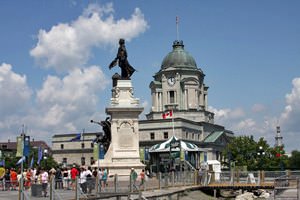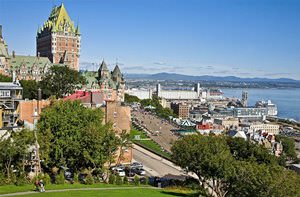 Chateau Frontenac, Parliament Building, Gare du Palais, and Quebec Bridge are the architectural landmarks, the names of which always remind you the words 'Quebec City' and 'Canada'. And this is natural, since these prominent landmarks are the ones that shape the historical and architectural look of Quebec City. Let’s look at these landmarks from high above, namely, from a bird’s eye view – click the video and make a flight over the architectural ensemble of Quebec City. In the main article, you can also read the most interesting facts about every famous landmark of Quebec City.
Chateau Frontenac, Parliament Building, Gare du Palais, and Quebec Bridge are the architectural landmarks, the names of which always remind you the words 'Quebec City' and 'Canada'. And this is natural, since these prominent landmarks are the ones that shape the historical and architectural look of Quebec City. Let’s look at these landmarks from high above, namely, from a bird’s eye view – click the video and make a flight over the architectural ensemble of Quebec City. In the main article, you can also read the most interesting facts about every famous landmark of Quebec City.
Chateau Frontenac, Quebec
Location on the map:  Facts:
Facts:
» The castle was built at the top of a cliff. That is why the building seems to be higher than nearby constructions. » You can see the silhouette of the manor on postage stamps. Politicians and creative individuals stayed at Chateau Frontenac.
» The castle looks really majestic with its red brick walls, green roof, and different sized spires. Its central tower has 20 levels. The openwork stairs lead to apartments where most of the interior items are made of marble. Walls and ceilings are decorated with carved moldings. The walls of the halls are paneled and covered with tapestries. In the rooms, you can see fireplaces that impress with their size, interesting lamps, and snow-white drapes.
» Chateau Frontenac was named after the French Governor who ruled in the 17th century.
» The Canadian National Company builds extraordinary hotels all over the world to demonstrate its financial power. Chateau Frontenac is the symbol of financial soundness.
» The services include an introductory tour with a guide wearing a livery or a guide-dog.
» Chateau Frontenac is recorded in the Guinness Book of Records as the most unusual place for recreation.
Parliament Building, Quebec
Location on the map:  Facts:
Facts:
» The representative body and the legislative body - the Province Deputy Governor and The Legislative Assembly of Quebec - meet in the eight-storey Parliament Building. » Its construction began in 1877 and was finished in 9 years. According to the historical fact, in January 1948, the flag that symbolizes independence from Canada was hung over the building.
» There is a 52-meter tower with a built-in clock in the center of the four-tier construction. The first session of the government body was held here on 27 April 1886.
» There are multiple sculptures outside the building. Each of them is dedicated to a political figure, e.g. the founder, the governor, and to settlers. The fresco depicts the Indian family.
» The interior features wooden panels, gilded elements, and marble. On the walls, you can see different families’ symbols: the Fleur-de-Lis, and the initials of Queen Victoria that remind of the use of two languages in Canada.
» The Blue Salon where meetings are held is open for visitors.
» Several buildings were added to the central one afterwards. They exist as a single complex today.
Gare du Palais, Quebec
Location on the map:  Facts:
Facts:
» The railway station services the line between city districts. The passenger point provides both railway and bus services. » The name of the railway station is symbolic: this is the name of the intendant of New France.
» The building was built upon the order of the administration of the Canadian National Railway in 1915.
» The two-storey construction resembles not an official institution but a castle with its appearance. It was built in the style of so-called chateauesque (Francis I style). It features sophisticated towers, high spires, and a round roof. This architectural style is expressed in the exterior of the railway station too.
» The facade is made of decorative blocks. It is crowned with a blue many-tier roof. There is a tower with an old built-in clock.
» The regular scheduled services were ceased from 1976 to 1985. Today, you can travel on the western line to the Montreal Station.
» Inner rooms are characterized by some solemnity and elegance. The walls are painted milk-white. They make a contrast with the dark tiled floor.
» There are all the conditions for you waiting for the train: a recreation hall, ticket offices, an information desk, and a cafe.
Quebec Bridge, Quebec
Location on the map:  Facts:
Facts:
» The Quebec Bridge belongs to the Canadian National Railway. The project of the bridge has been discussed for 50 years. » The highway is almost 1000 m long, 29 m wide, and 104 m high. The support of the bridge is fixed with bolts of a diameter of 0.6 m.
» The bridge structure includes a parking area, an overpass, and a pedestrian walkway. The bridge’s purpose is to link the southwestern district of Quebec and Levi across the Saint Lawrence River.
» $1.5 million was allocated for the construction of the build. It was not enough. The construction lasted 19 years.
» The Prince of Wales took part in the bridge opening ceremony.
» The negligence of workers, incorrect calculations of engineers, and the use of cheap materials caused the tragedy. As a result, 75 people were injured. The unfinished arch covering fell. 19 tons of twisted metal literally overlaid the river.
» In 1916, the bridge was destroyed for the second time. The part of the lifting mechanism was not able to support the weight of the construction. The ruins of the bridge are still lying on the bottom of the river.
» Today, there are all the conditions for the bridge functioning. The object is under the protection of the State.
Saint-Sacrement Church, Quebec
Facts: » At one time, there was a Bernadine monastery (for Catholic monks) at the site of the church.
» The construction of the House of God began in 1671. It is built of granite bricks.
» Its walls are faced with relief masonry that creates an unusual picture. There are three windows above the central entrance.
» There is a bas-relief of the 18th century in the center (its creator is unknown). It depicts St. Benedict and Bernard telling people the Good News.
» There are small windows with grilles o both sides of the fresco. They are decorated with superimposed convex elements.
» There is another hall, an atrium, inside. Some paintings of famous Spanish artists are kept here.
Citadelle of Quebec, Quebec
Facts: » The star-shaped Citadelle of Quebec is the part of the fortification located in the Old City, atop Cap Diamant. It still serves as a military base.
» There is the monarch’s headquarter that serves as the residence of the Governor General of the country.
» The fortress was opened as a fortification construction in 1690. This is because of battles between British and French troops.
» Today, you can see the fortress that has remained unchangeable since 1850. The complex consists of 25 constructions. The 22nd Royal Regiment of 200 soldiers has settled here.
» Traditionally, there is a guard changing ceremony every morning. Soldiers march under the fraction of drums. They wear a special uniform: red ammunition and fur hats. They hold old rifles in their hands.
» The goat walks freely walks in the territory. It is an “amulet” of the fortress.
» Mass military music festivals are held here. Almost 700 people take part in it.
» In the fortification, there is a preserved Powder Tower and a defense round construction.
» In the Citadelle of Quebec, the UN Declaration on Education was adopted.







